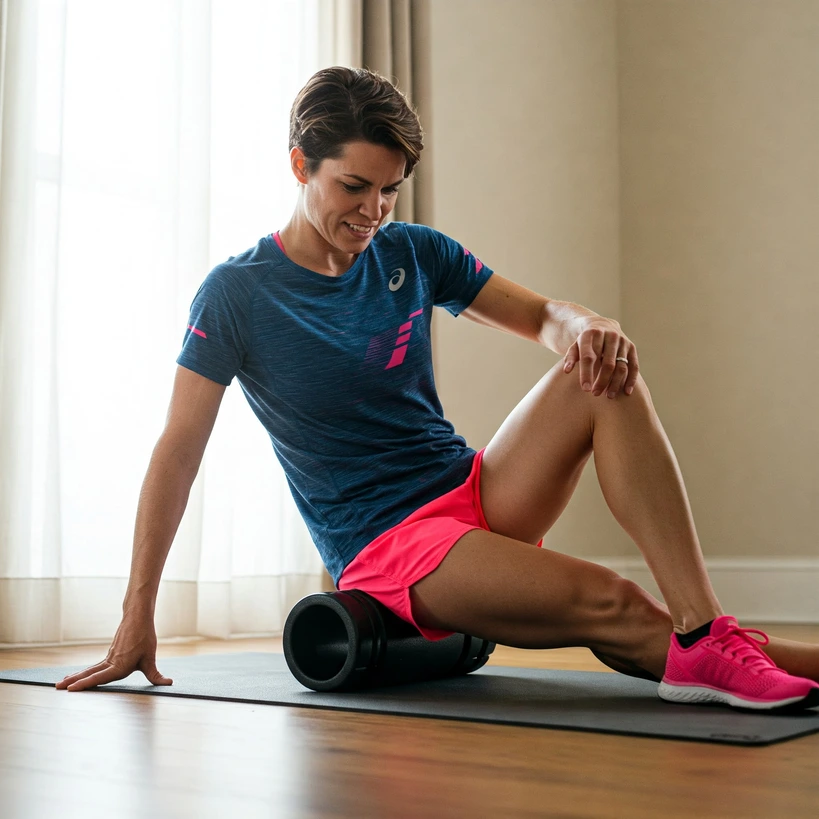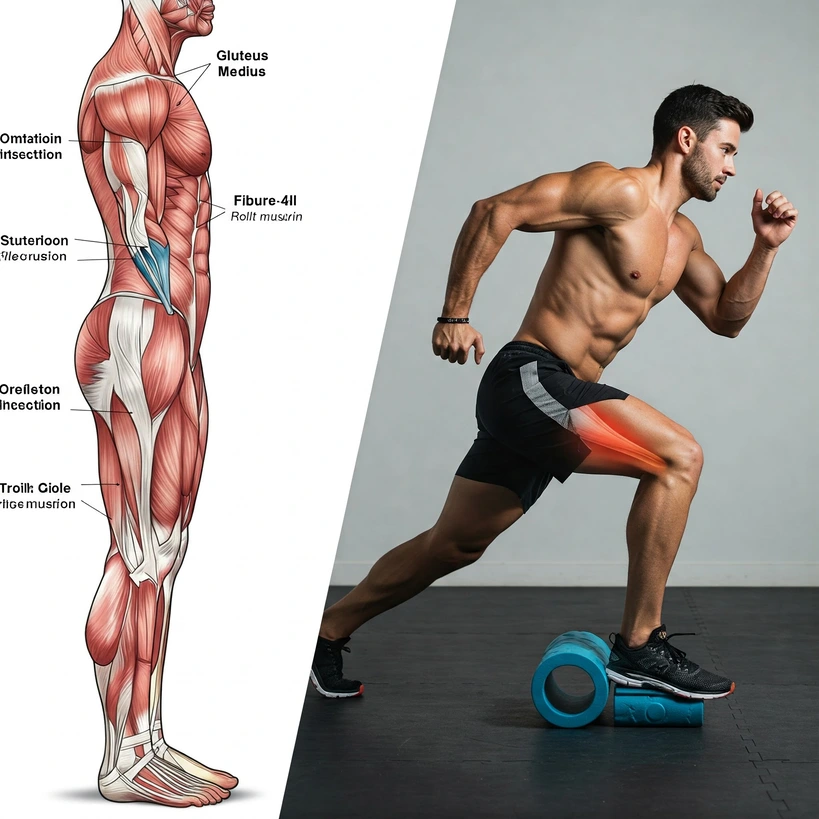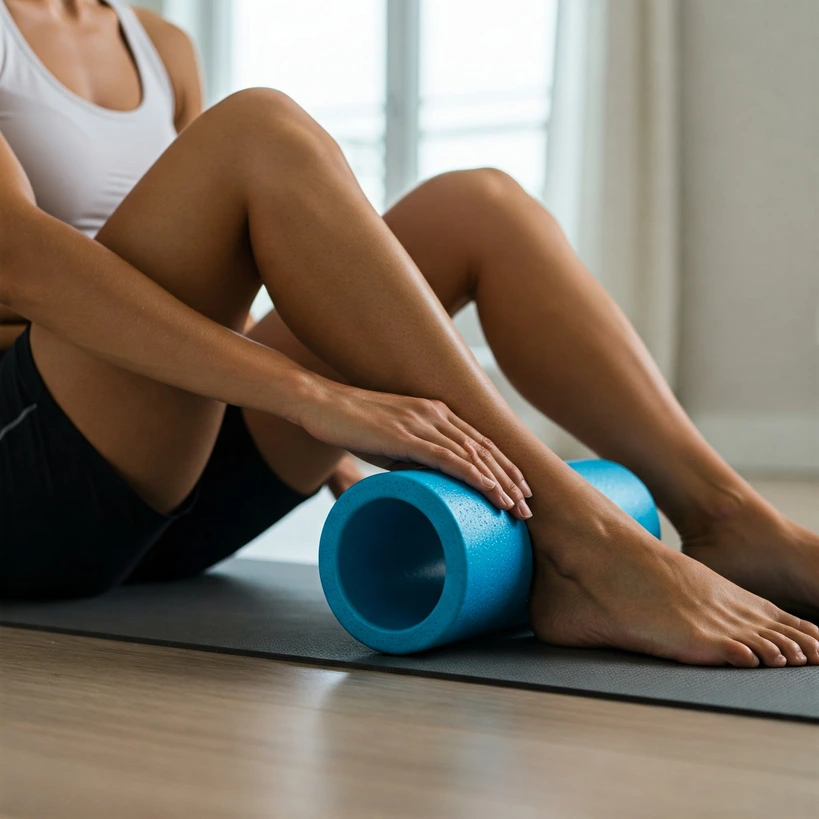Introduction: The Ultra Runner’s Recovery Imperative and the Role of Foam Rolling
Ultra running pushes the boundaries of human endurance, subjecting the musculoskeletal system to extraordinary and prolonged stress. The repetitive impact over vast distances, often across challenging terrain, necessitates robust recovery strategies not just for performance enhancement but for injury prevention and long-term participation in the sport. Without effective recovery, the cumulative microtrauma, muscle soreness, and fatigue inherent in ultra running can lead to performance decrements and a heightened risk of overuse injuries.
In the search for accessible and effective recovery methods, foam rolling, a form of self-myofascial release (SMR), has gained significant popularity among athletes of all levels, including ultra runners. This technique involves using a foam roller or similar tool to apply pressure to soft tissues, aiming to improve muscle function, flexibility, and recovery. It is often employed both as part of a warm-up routine and, more commonly, as a post-exercise recovery modality. This guide delves into the evidence-based use of foam rolling for ultra runners, covering its mechanisms, benefits, specific techniques for key muscle groups, managing IT Band Syndrome (ITBS), and optimizing your routine.
The Science Behind Foam Rolling for Ultra Runners: Mechanisms and Benefits
- Defining Foam Rolling (SMR): Foam rolling is a self-administered technique using body weight and a tool (roller, ball, stick) to apply pressure to muscles and fascia. It’s a form of self-massage, offering accessibility and efficiency compared to manual therapy.
- Proposed Mechanisms: While exact mechanisms are still studied, theories include:
- Neurophysiological Effects: Stimulating mechanoreceptors may reduce pain perception and muscle tension via central pain modulation (DNIC) and potentially parasympathetic activation.
- Mechanical/Fluid Effects: Pressure might affect tissue structure, reduce stiffness, and influence tissue hydration. The idea of breaking adhesions is debated.
- Circulatory Effects: Foam rolling can improve local circulation, potentially reducing arterial stiffness and enhancing blood flow, which may aid recovery and reduce fatigue.
- Psychophysiological Effects: Self-care and potential placebo effects may contribute to perceived well-being. The benefits likely arise from a combination of these factors.
- Key Benefits: Research consistently supports several benefits relevant to ultra runners:
- Enhanced Recovery & Reduced DOMS: Foam rolling significantly reduces delayed onset muscle soreness (DOMS) after strenuous exercise. It lessens muscle tenderness and can speed the recovery of muscle function (power, strength-endurance). This improves training tolerance.
- Improved Flexibility & ROM: Foam rolling provides acute increases in flexibility and joint range of motion (ROM). Regular use may offer long-term benefits. Importantly, unlike static stretching, it improves ROM without negatively impacting subsequent muscle performance. Combining it with static stretching might yield even greater gains.
- Potential Performance Effects (Minor): Direct performance impact is generally minor. Pre-exercise rolling may offer small sprint improvements; post-exercise rolling might slightly lessen performance decline after fatigue. It doesn’t seem to harm muscle tissue.
- Potential Injury Prevention (Indirect): While direct evidence is limited, by improving ROM, reducing soreness/stiffness, and potentially enhancing neuromuscular efficiency, foam rolling may help mitigate injury risk factors common in ultra running.
For ultra runners, the most significant benefits are managing DOMS and enhancing flexibility. Improved recovery and movement quality are critical for handling high training loads. Its ability to increase ROM without performance deficits makes it useful pre-run, especially with dynamic movements.
Ultra Running’s Toll: Key Muscle Groups and Biomechanical Stress
Ultra running’s prolonged duration, repetitive impacts, and varied terrain place immense stress on the body. Key muscle groups heavily taxed include:
- Quadriceps: Crucial for uphill propulsion and eccentric control during downhills (major source of soreness).
- Hamstrings: Important for hip extension (push-off) and controlling lower leg swing; chronic tightness is common.
- Gluteals (Maximus, Medius, Minimus): Gluteus maximus provides power for hip extension; Gluteus medius is vital for pelvic stability during single-leg stance. Glute medius weakness is strongly linked to hip drop, knee valgus, and increased injury risk.
- Calves (Gastrocnemius & Soleus): Essential for push-off and shock absorption; heavily loaded, especially uphill or with forefoot striking.
- Hip Flexors (Iliopsoas, TFL): Lift the knee; the TFL attaches to the IT band, and tightness can increase IT band tension.
- Lower Back/Core: Maintain posture; fatigue can increase stress here.
- Tibialis Anterior: Controls foot landing and dorsiflexion; overuse can lead to shin splints.
- Biomechanical Considerations:
- Impact Forces: High cumulative load from repeated impacts, especially eccentric downhill forces, causes muscle damage.
- Common Faults: Fatigue often exacerbates weaknesses (esp. glute medius), leading to hip drop, knee valgus, crossover gait, over-striding, or poor posture, increasing stress and injury risk.
- Kinetic Chain: Imbalances affect the entire system (e.g., weak glutes impacting knee/IT band).
Gluteal function is foundational for resilient ultra running biomechanics. Stabilizing the pelvis via strong glutes helps manage high loads. Perceived tightness in hamstrings or hip flexors might be symptomatic of underlying weakness elsewhere (e.g., glutes). Foam rolling can offer temporary relief, but addressing root causes (weakness) via strengthening is crucial long-term.
Essential Foam Rolling Exercises for Ultra Runners: A Practical Guide
- General Technique Principles:
- Slow & Controlled: About one inch per second.
- Address Tender Spots: Pause/hold pressure (20-30s) or use small oscillations until tenderness eases; avoid sharp pain.
- Breathe: Deep, relaxed breathing.
- Avoid Joints/Bones: Focus on muscle belly; avoid kneecaps, hip bones, spine. Caution with lower back rolling.
- Maintain Core Engagement: Protect lower back/shoulders.
- Pressure Modulation: Adjust body weight; start lighter if tender. Slow speed and sustained pressure seem key for therapeutic effects.
- Targeted Exercises:
- Quadriceps: Prone position, support on elbows. Roller under one thigh. Roll slowly from below hip to above knee. Rotate body slightly to hit different aspects.
- Hamstrings: Seated, roller under thighs, support with hands behind. Lift hips. Roll from below glutes to above knee. Cross ankle over for more pressure.
- Gluteals (Maximus & Medius/Piriformis): Seated on roller. Cross ankle over opposite knee (“figure-4”). Lean towards crossed leg side. Roll over buttock area. Crucial for hip stability/IT band issues.
- Calves: Seated, roller under calves, support with hands. Lift hips. Roll from below knee towards Achilles. Cross leg over for pressure. Rotate leg, point/flex foot.
- Hip Flexors/TFL: Prone/angled, roller high on front/outer hip below bony point (ASIS). Support on forearms/opposite leg. Small, controlled movements. Be cautious, avoid hip bone. Important for IT band tension.
- Adductors (Inner Thigh): Prone, leg bent out to side, inner thigh on roller near groin. Support on forearms/straight leg. Shift weight side-to-side towards inner knee.
- Upper/Mid Back (Thoracic Spine): Supine, roller under shoulder blades, knees bent, feet flat. Support head. Lift hips slightly. Roll between mid-back and neck base. Avoid direct pressure on lower back. Relieves postural tension.
- (Optional) Lats: Lie on side, arm extended overhead. Roller under armpit/side ribs. Roll gently. Good for upper body tightness.
Including adductors and TFL provides a comprehensive approach, addressing key muscles in lower limb mechanics and injury prevention.
Decoding Iliotibial Band Syndrome (ITBS) in Ultra Runners
ITBS is a common overuse injury causing pain on the outer knee.
- What is the IT Band? A thick band of fascia (not muscle) running from the hip (TFL/Glute Max) down the outer thigh to below the knee. It helps stabilize the hip/knee.
- What is ITBS? Overuse injury with pain on the outer knee, sometimes radiating. Very common in runners.
- Understanding the Cause: Previously thought to be friction, newer understanding emphasizes compression of the nerve-rich fat pad under the IT band against the femur bone during repetitive knee bending. Inflammation of the band or underlying bursa can occur.
- Common Causes/Risk Factors: Usually a combination of factors:
- Training Errors: Abrupt increases in mileage/intensity, excessive downhill running, running on cambered surfaces, inadequate rest. Trail running’s varied terrain increases risk.
- Biomechanical/Muscle Imbalances: Hip abductor (Glute Medius) weakness is key, leading to poor femur/pelvis control (hip adduction, internal rotation, knee valgus). Weak glute max/core also contribute. Tight TFL increases IT band tension.
- Running Form: Crossover gait, overstriding.
- Foot Mechanics: Excessive pronation.
- Other: Worn shoes, structural issues (leg length difference). ITBS often results from overload exceeding tissue capacity, frequently due to underlying biomechanical issues. The IT band is often the victim, not the culprit.
- Symptoms:
- Sharp/burning pain on outer knee.
- Pain starts predictably during run, worsens with activity. May linger post-activity or occur with walking/stairs.
- Worse downhill/descending stairs, cycling.
- Tenderness to touch on outer knee.
- Possible clicking/snapping sensation.
- Possible swelling/redness/warmth in severe cases. The pattern highlights its cumulative stress nature. Simply resting is often insufficient; addressing underlying factors is key for prevention.

Strategic Foam Rolling for IT Band Pain Relief: Targeting the Source
- The Controversy: Rolling directly on the IT band, especially the painful outer knee, is often advised but may be counterproductive. The IT band is dense fascia, not muscle, and doesn’t readily “loosen”. Direct pressure might increase compression and inflammation, worsening pain.
- Focus on Associated Muscles: A better strategy is rolling the muscles that influence IT band tension and mechanics:
- TFL: Muscle at front/side hip attaching to IT band. Rolling here reduces tension.
- Gluteus Maximus & Medius: Rolling these key hip extensors/stabilizers helps restore proper hip function, reducing downstream strain.
- Quadriceps (Vastus Lateralis): Outermost quad muscle adjacent to IT band. Rolling here may reduce lateral tension (avoid direct pressure on the band if acutely painful).
- Hamstrings: Addressing tightness improves overall leg mechanics. Use general techniques (slow, controlled, hold tender spots) on these surrounding muscles. Aim for muscle tissue, not the dense band itself near the knee. This addresses dysfunction sources rather than just the pain site. You release tension in muscles pulling on the band (TFL, Glute Max) and improve function of stabilizers (Glute Med).
- Integration with Other Strategies: Foam rolling is just one part of ITBS management. Combine it with:
- Strengthening: Crucial. Target hip abductors (Glute Med), Glute Max, core. Examples: clamshells, bridges, single-leg deadlifts.
- Stretching: Gentle stretches for TFL, glutes, quads, hamstrings.
- Load Management: Temporarily reduce volume/intensity/downhills; gradual return.
- Gait Retraining: Address form issues like crossover gait if needed (seek professional help).
- Other Treatments: Physical therapy, ice, appropriate footwear may be needed.
Optimizing Your Foam Rolling Routine: Frequency, Duration, and Timing
- Frequency: Consistency is key. Recommendations range from 2-3 times/week to daily. Daily may be good during heavy training or managing issues like ITBS. Listen to your body.
- Duration per Muscle Group: Aim for approx. 60-120 seconds per major muscle group/area. Within this, pause 20-30s on tender spots. Quality over quantity.
- Overall Session Length: Typically 10-20 minutes. Can be shorter if targeting fewer areas.
- Timing:
- Post-Exercise (Recovery): Highly effective. Reduces DOMS, aids muscle function recovery. Likely the most impactful timing for ultra runners due to high muscle damage.
- Pre-Exercise (Warm-up): Increases ROM without performance drop. Best combined with dynamic stretching/active warm-up.
- Rest Days / General Mobility: Good for maintenance and relaxation.
- Roller Choice: Soft/smooth for beginners/sensitive areas; dense/textured for deeper pressure. Sufficient duration might matter more than texture. Smaller tools (balls, sticks) useful for specific areas/portability.
Experiment to find what works best for your individual needs and tolerance. Consistency within evidence-based ranges is important.
Avoiding Common Pitfalls: Foam Rolling Best Practices and Safety
- Common Mistakes:
- Rolling Too Fast: Reduces effectiveness.
- Rolling Joints/Bones: Painful/potentially harmful. Avoid lumbar spine directly.
- Rolling Acute Injuries/Inflammation: Can aggravate. Work around the area. Consult a professional if unsure.
- Excessive Time on One Spot: Could irritate nerves/vessels. Stick to guidelines.
- Too Much Pressure/Excessive Pain: “Good pain” is okay, sharp/unbearable pain is not. Reduce pressure if needed. Pushing through severe pain is counterproductive.
- Poor Posture/Form: Can strain other areas (shoulders, back).
- Holding Breath: Increases tension. Breathe deeply.
- Expecting Miracles/Isolation: It’s a tool, not a fix-all. Complements good training, sleep, nutrition. Mistakes often stem from treating it as aggressive smashing rather than controlled stimulus.
- Safety Considerations:
- Start Gently: Beginners use less pressure/duration, softer roller.
- Listen to Your Body: Adjust/stop based on pain signals.
- Consult Professionals: If pain persists or unsure due to injury/condition.
- Certain Conditions: Use caution with severe osteoporosis, bleeding disorders, vascular issues (DVT, severe varicose veins), open wounds/infections. User control over pressure requires self-awareness.
Beyond the Roller: Integrating Complementary Recovery Strategies
Foam rolling is best used within a broader recovery plan. Include:
- Stretching:
- Static: Improves long-term flexibility. Best after rolling or separate session. May enhance ROM gains when done post-rolling. Target key runner muscles.
- Dynamic: Active movements for pre-run warm-up. Pairs well with pre-run rolling.
- Active Recovery: Low-intensity activity (walking, cycling) promotes blood flow, reduces stiffness.
- Strength Training: Non-negotiable. Addresses underlying weaknesses (glutes, hips, core) that cause injuries like ITBS. Focus on stability, single-leg strength, core control. Synergistic with foam rolling.
- Massage Therapy: Professional massage offers deeper, targeted work. Foam rolling complements this.
- Nutrition & Hydration: Essential for muscle repair, energy replenishment, and function.
- Sleep: Most critical recovery tool. Vital for repair, hormone release, adaptation. Deprivation impairs recovery and increases injury risk.
- Other Modalities: Compression garments (efficacy needs more research), cryotherapy/ice, heat therapy.
A comprehensive plan addresses systemic demands. Foam rolling targets specific issues (soreness, mobility) but can’t replace sleep, nutrition, load management, or strength training. It’s a valuable tool within this larger ecosystem.

Conclusion: Rolling Towards Resilience
Foam rolling is a popular, accessible tool for ultra runners. Evidence shows it effectively reduces DOMS and improves short-term flexibility/ROM when done correctly. Proper technique (slow, controlled pressure, avoiding joints/acute inflammation) is key. For ITBS, targeting associated muscles (TFL, glutes) is likely more beneficial than rolling the painful site directly.
Crucially, view foam rolling as one component of a holistic strategy. Integrate it with sleep, nutrition, smart training, and especially targeted strength training to address root causes of injury. By using foam rolling thoughtfully and consistently within a comprehensive self-care plan, ultra runners can enhance recovery, maintain mobility, potentially reduce injury risk, and support their long-term resilience in the sport.
Below is a list of the scientific studies, articles, and reliable sources that form the basis for the information and recommendations shared in this blog post. You can refer to these resources for further details or a more in-depth exploration of the topic. These references support the accuracy and timeliness of the information presented.
- The Consequences of Training and Competition to the Musculoskeletal System in Ultramarathon Runners: A Narrative Review – PMC – PubMed Central (Accessed: April 13, 2025)
- Rehabilitation of Running Biomechanics – Physiopedia (Accessed: April 13, 2025)
- A Meta-Analysis of the Effects of Foam Rolling on Performance and Recovery – PMC (Accessed: April 13, 2025)
- Effects of Self-Myofascial Release on Athletes’ Physical Performance: A Systematic Review (Accessed: April 13, 2025)
- Selective Effects of Manual Massage and Foam Rolling on Perceived Recovery and Performance – PubMed Central (Accessed: April 13, 2025)
- FOAM ROLLING FOR PERFORMANCE AND RECOVERY – National Strength and Conditioning Association (NSCA) (Accessed: April 13, 2025)
- How to use a foam roller, plus 5 exercises to help tired muscles recover – Runner’s World (Accessed: April 13, 2025)
- Foam Rolling for Recovery – Issuu (Accessed: April 13, 2025)
- Effects of foam rolling on performance and recovery: A systematic review of the literature to guide practitioners on the use of foam rolling – PubMed (Accessed: April 13, 2025)
- IT Band Syndrome: Symptoms, Causes, and Care – UPMC (Accessed: April 13, 2025)
- Iliotibial Band Syndrome (“Runner’s Knee”) | Complete Physio (Accessed: April 13, 2025)
- Tips for Trail Runners—How to Avoid (and Treat) IT Band Syndrome (Accessed: April 13, 2025)
- Foam Rolling for Delayed-Onset Muscle Soreness and Recovery of Dynamic Performance Measures – PMC (Accessed: April 13, 2025)
- Preventive and Regenerative Foam Rolling are Equally Effective in Reducing Fatigue-Related Impairments of Muscle Function following Exercise (Accessed: April 13, 2025)
- (PDF) Effects of the use of foam rollers by high-performance athletes on range of motion, flexibility, strength and delayed onset muscle soreness – ResearchGate (Accessed: April 13, 2025)
- Self-Myofascial Release Effect With Foam Rolling on Recovery After High-Intensity Interval Training – Frontiers (Accessed: April 13, 2025)
- Foam rolling is an effective recovery tool in trained distance runners – PubMed (Accessed: April 13, 2025)
- Should You Try Foam Rolling? – Cleveland Clinic Health Essentials (Accessed: April 13, 2025)
- Research in Review: Does foam rolling decrease DOMS and aid performance? (Accessed: April 13, 2025)
- Trail Mastery: Harnessing Muscle Elasticity for Optimal Trail Running Performance (Accessed: April 13, 2025)
- Recovery effect of self‐myofascial release treatment using different type of a foam rollers (Accessed: April 13, 2025)
- Roll away the foam: the truth about foam rolling for athletes – Sports Performance Bulletin (Accessed: April 13, 2025)
- Key mechanical stresses to the musculoskeletal system during trail running and motion strategies required to mitigate injury risk. – ResearchGate (Accessed: April 13, 2025)
- Running Form, Biomechanics, and Drills – Ultra Running Magazine (Accessed: April 13, 2025)
- Running Biomechanics – Physiopedia (Accessed: April 13, 2025)
- 4 Foam Rolling Tips for Endurance Athletes – TrainingPeaks (Accessed: April 13, 2025)
- Running Biomechanics: Gluteal Compensation Patterns – Precision Physical Therapy (Accessed: April 13, 2025)
- Ultra PT: The Dreaded IT Band Syndrome – Ultra Running Magazine (Accessed: April 13, 2025)
- Everything you need to know about IT band syndrome – Runner’s World (Accessed: April 13, 2025)
- IT Band Syndrome in Runners | BenchMark Physical Therapy (Accessed: April 13, 2025)
- Delving into the World of Strength Training for Ultra runners (Accessed: April 13, 2025)
- The biomechanics of running and running styles: a synthesis – Taylor & Francis Online (Accessed: April 13, 2025)
- Iliotibial Band Syndrome (ITBS): Causes, Symptoms & Treatment – Cleveland Clinic (Accessed: April 13, 2025)
- Iliotibial Band Syndrome/Runner’s Knee Symptoms and Treatment – Insoles.com (Accessed: April 13, 2025)
- Iliotibial (IT) Band Syndrome: Causes, Symptoms, Treatment – WebMD (Accessed: April 13, 2025)
- Understanding and Managing IT Band Syndrome in Runners (Accessed: April 13, 2025)

About the Author
Lost Pace is an ultramarathon runner, shoe-tester and the founder of umit.net. Based year-round in Türkiye’s rugged Kaçkar Mountains, he has logged 10,000 + km of technical trail running and completed multiple 50 K–100 K ultras.
Blending mountain grit with data, Lost analyses power (CP 300 W), HRV and nutrition to craft evidence-backed training plans. He has co-written 260 + long-form guides on footwear science, recovery and endurance nutrition, and is a regular beta-tester of AI-driven coaching tools.
When he isn’t chasing PRs or testing midsoles, you’ll find him sharing peer-reviewed research in plain English to help runners train smarter, stay healthier and finish stronger.
Ultrarunner · Data geek · Vegan athlete

